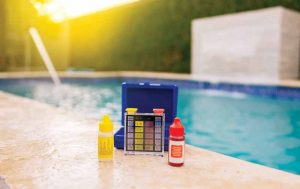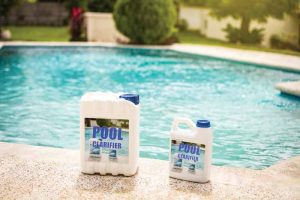
How borates prevent algae growth
An effective way to control algae is by adding borates to the pool. At a level of 50 ppm, they will help reduce algae’s ability to grow. However, it should be understood the borates will not kill existing algae which has already bloomed. Borates are considered algaestats rather than algaecides. While they cannot affect bloomed algae, they act as inhibitors to prevent cell wall development, metabolism, and cell division. If left unchecked, algae cells have the ability to divide and double in population within three to eight hours. If the algae is allowed to reach this stage, it will consume chlorine and visible algae will appear. Since borates prevent the cell division process, algae cannot grow or consume the chlorine in the pool water. Borates also act as a buffer to prevent the pH from increasing. If the pH is controlled, it will be harder for algae to grow. In addition, because borates help soften the water, chlorine and algaecides can more easily penetrate any algae spores.
The optimal and most cost-effective type of borate product is boric acid. It takes 21.5 kg (47.5 lb) of boric acid to get 50 ppm in a 75,708.2-L (20,000-gal) pool.11
Some of the best water quality practices to help reduce the potential for algae include:
- Maintaining a pH of 7.2 to 7.5 (the lower
the better). - Keeping a CYA level of no more than 30 ppm.
- Ensuring phosphates remain below 200 ppb.
- Managing nitrates to less than 10 ppm.
- Adding borates at level of 50 ppm.

Algaecides can also be used and are recommended during warm weather conditions and heavy swimming seasons. Polyquat is one of the best algae preventors, and is ideal for the prevention of green, free-floating algae. Copper-based algaecides are effective against blue-green forms of cyanobacteria, black algae, and yellow algae. As long as the pH of the water remains balanced, staining from metallic algaecide should not be a problem. There are also products which incorporate the use of sodium ammonium combined with chlorine, to bring the pool from green back to blue within 24 hours. While these additional tools will help keep algae out of pools, good water quality practices and regular brushing are still the best foundational routines for prevention.12, 13
Notes
1 Read How Many Species of Algae Are There? Phycological Society of America, 2012.
2 Refer to Service Tech Manual, Pool and Hot Tub Alliance (PHTA), 2019.
3 See ABCs of Algae, PHTA Recreational Water Air Quality Committee, 2018 Tech Notes, AQUA Magazine.
4 Consult AquaTech Best Practices for Pool and Aquatic Facility Operators, Human Kinetics, Inc., 2008.
5 See Pool Chemistry for Residential Pools, Lowry Consulting Group, LLC, 2018.
6 Refer to White’s Handbook of Chlorination and Alternative Disinfectants, 5th Edition, John Wiley and Sons, Inc., 2010.
7 See note 5.
8 Refer to Optimal Corrosion Control Treatment Evaluation Technical Recommendations for Primacy Agencies and Public Water Systems, United States Environmental Protection Agency (EPA), 2016.
9 Consult Management of Phosphates in Recreational Waters for Optimum Algae Control, by Everett Nichols, PhD, Proceedings Vol. III, NSPI Chemistry Symposium, 1998.
10 See note 9.
11 See note 5.
12 Read Swimming Pool Care “The Essential Guide,” David Van Brunt, 2018.
13 Consult Pool and Spa Operator Handbook, Pool and Hot Tub Alliance (PHTA), 2017.
 Author
Author
Terry Arko is a product training and content manager for HASA Pool Inc., a manufacturer and distributor of pool and spa water treatment products in Saugus, California. He has more than 40 years’ experience in the pool and spa/hot tub industry, working in service, repair, retail sales, chemical manufacturing, technical service, commercial sales, and product development. He has written more than 100 published articles on water chemistry and has been an instructor of water chemistry courses for more than 25 years. Arko serves as a voting member on the board of the Recreational Water Quality Committee (RWQC). He is a commercial pool operator (CPO) course instructor, a teacher of the Pool Chemistry Certified Residential course for the Pool Chemistry Training Institute (PCTI), a California Pool and Spa Association (CPSA) board member, and a member of Pool & Spa Marketing’s editorial advisory committee. He can be reached via email at terryarko@hasapool.com.






